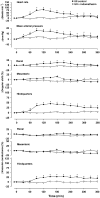Regional heterogeneity in the haemodynamic responses to urotensin II infusion in relation to UT receptor localisation
- PMID: 16314853
- PMCID: PMC1751348
- DOI: 10.1038/sj.bjp.0706503
Regional heterogeneity in the haemodynamic responses to urotensin II infusion in relation to UT receptor localisation
Abstract
The aim of the study was to measure regional haemodynamic responses to 6 h infusions of human urotensin II (hUII), to identify possible mediators of the effects observed, and to relate the findings to the distribution of urotensin II receptors (UT receptors). Male, Sprague-Dawley rats had pulsed Doppler flow probes and intravascular catheters implanted for measurement of regional haemodynamics in the conscious, freely moving state. Infusions of saline (0.4 ml h(-1)) or hUII (30, 300 and 3,000 pmol kg(-1) h(-1)) were given i.v. for 6 h, and the effects of pretreatment with indomethacin (5 mg kg(-1) h(-1)), N(G)-nitro-L-arginine methyl ester (L-NAME, 3 mg kg(-1) h(-1)) or propranolol (1 mg kg(-1); 0.5 mg kg(-1) h(-1)) on responses to hUII (300 pmol kg(-1) h(-1) for 6 h) were assessed. Cellular localisation of UT receptor-like immunoreactivity was determined in relevant tissues. hUII caused dose-dependent tachycardia and hindquarters vasodilatation, accompanied by a slowly developing rise in blood pressure. Haemodynamic effects of hUII were attenuated by propranolol or L-NAME and abolished by indomethacin. UT receptor-like immunoreactivity was detected in skeletal and vascular smooth muscle. The findings indicate that in conscious rats, infusions of hUII cause vasodilatation, which, of the vascular beds monitored, is selective for the hindquarters and dependent on cyclooxygenase products and nitric oxide. The pressor effect of hUII under these conditions is likely to be due to an increase in cardiac output, possibly due to a positive inotropic effect. UT receptor-like immunoreactivity present in skeletal muscle is consistent with the haemodynamic pattern.
Figures





References
-
- ABDELRAHMAN A.M., PANG C.C.Y. Involvement of the nitric oxide/L-arginine and sympathetic nervous systems on the vasodepressor action of human urotensin II in anesthetized rats. Life Sci. 2002;71:819–825. - PubMed
-
- AMES R.S., SARAU H.M., CHAMBERS J.K., WILLETTE R.N., AIYAR N.V., ROMANIC A.M., LOUDEN C.S., FOLEY J.J., SAUERMEICH C.F., COATNEY R.W., AO Z., DISA J., HOLMES S.D., STADEL J.M., MARTIN J.D., LIU W.-S., GLOVER G.I., WILSON S., MCNULTY D.E., ELLIS C.E., ELSHOURBAGY N.A., SHABON U., TRILL J.J., HAY D.W.P., OHLSTEIN E.H., BERGSMA D.J., DOUGLAS S.A. Human urotensin-II is a potent vasoconstrictor and agonist for the orphan receptor GPR14. Nature. 1999;401:282–286. - PubMed
-
- CLIFFORD P.S., HELLSTEN Y. Vasodilatory mechanisms in contracting skeletal muscle. J. Appl. Physiol. 2004;97:393–403. - PubMed
Publication types
MeSH terms
Substances
LinkOut - more resources
Full Text Sources

